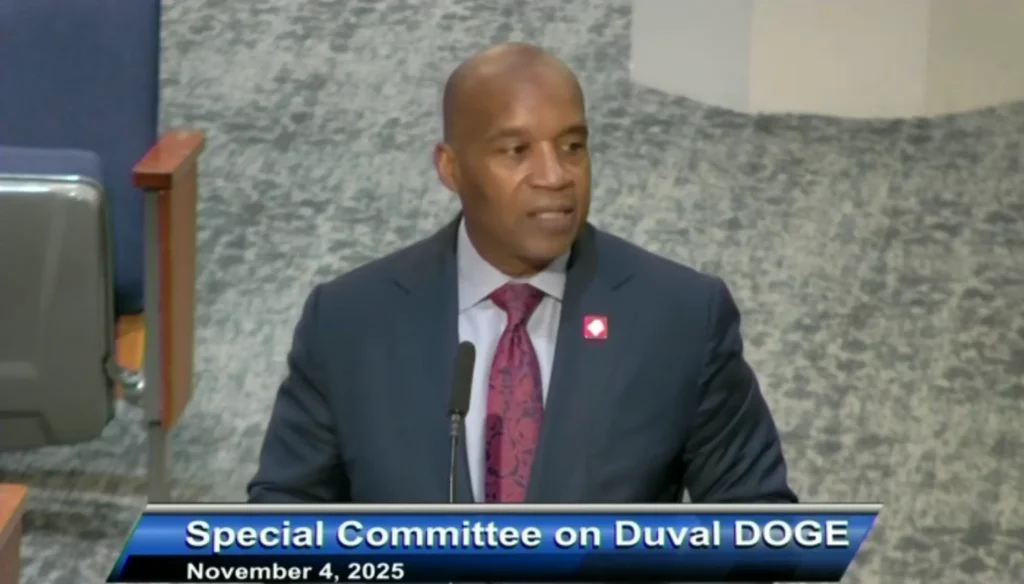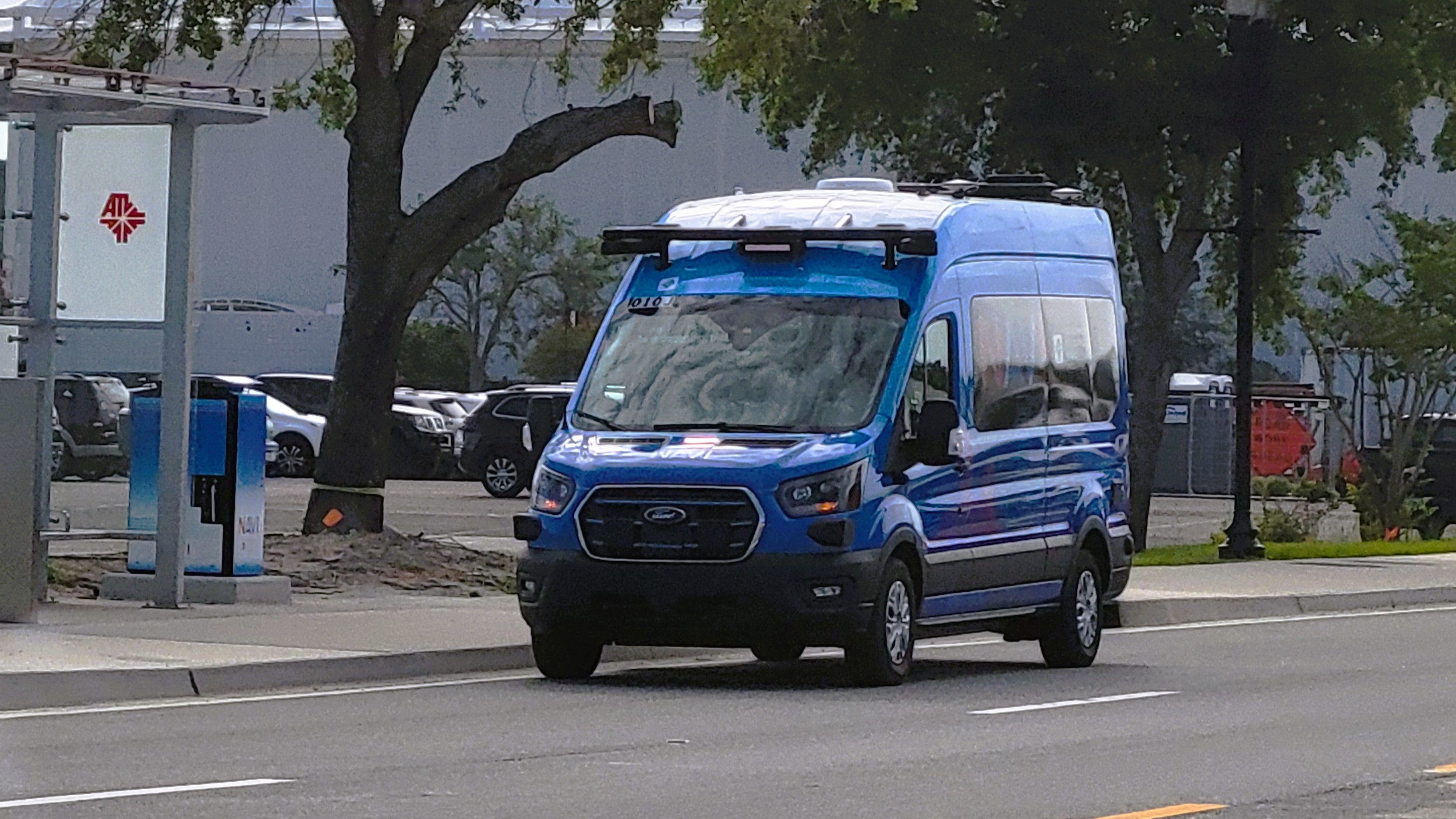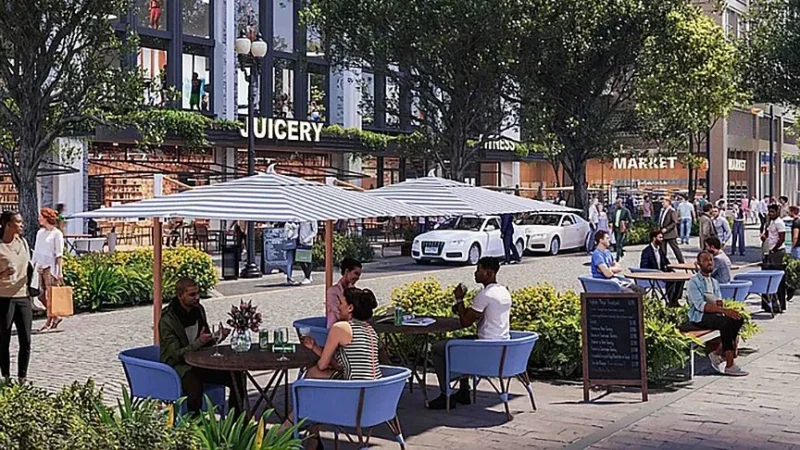A City Council committee is concerned about the viability of the city’s autonomous vehicle program.
The oversight committee on Tuesday questioned Jacksonville Transportation Authority CEO Nat Ford about the program — days after JTA released initial three-month ridership numbers for the first phase of the program, known as the Neighborhood Autonomous Vehicle Innovation, or NAVI.
Ridership fell short of some council members’ expectations. And at least one council member, Beaches representative Rory Diamond, tells Jacksonville Today that’s he’s considering legislation to redirect the local option gas tax funding reserved for the second phase of the project to other transportation projects.
JTA launched the NAVI driverless van service June 30 on a 3.5-mile loop along Bay Street Downtown. The shuttles have carried an average of 76 passengers per day with a total ridership of 6,578 people as of Oct. 30, according to figures provided this week to City Council’s Special Committee on Duval DOGE.
Diamond sits on the DOGE committee and called for the DOGE hearing into the autonomous vehicle program.
NAVI is the first phase of a larger plan known as the Ultimate Urban Circulator, or U2C. Diamond has referred to the estimated $400 million buildout plan for U2C as a risky investment for the city.
At the meeting, he told Ford he’s ready to “pull the plug” on the autonomous vehicle program in favor of more conventional mass transit options.
Diamond said in an interview Tuesday that he is “very likely” to introduce legislation that would redirect the $240 million gas tax money earmarked for the U2C to other projects like road resurfacing and reconstruction. But he says he wants to hear from council members outside the DOGE committee to gauge support of such a move.
“We’re just at a loggerheads when it comes to whether or not we should be doing the U2C program. I adamantly think we need to pull the plug. It sounds like they want to keep going. I think that’s throwing out good more for bad,” Diamond said. “At the very least, I bet you everyone would agree we’d be better off paving streets and making people’s commute to school or to work a little bit easier.”
Tax dollars + U2C
The concept for U2C was born out of a planning process that began a decade ago to replace Downtown’s aging elevated monorail Skyway system. JTA has been testing different automated vehicle options from various companies for years at its test facility.
JTA opened a control center for the autonomous vehicle control center in April in LaVilla as part of the $65 million Bay Street Innovation Corridor and NAVI phase of the U2C. It was paid for by $12.5 million in federal and $12.5 million in state funds and $40 million from JTA.
Phase II will replace the Skyway cars with autonomous vehicles, retrofit the elevated track and integrate it into the Bay Street loop. It will undergo a final study in January through 2027 to update construction costs and verify the project would be viable.
Current estimates say the third phase, expanding the system into Brooklyn, Riverside, San Marco and Springfield, will cost $95 million, but JTA says in a letter to DOGE that the January study will refine those costs, too.
“The U2C is a very ambitious and challenging project,” For said. “It’s probably the most challenging project in the JTA’s history. We began this innovative mobility program with regulations, no blueprint, no one that we could follow or copy. We built it from scratch, and we’re very proud of that work.”
Ford argued Tuesday that developing, testing and implementing the U2C technology has put Jacksonville in front of where mass transit is headed globally. He said the U2C is the reason that German autonomous vehicle manufacturer Holon has agreed to build a vehicle plant in Jacksonville and move its headquarters to the city from Michigan.
JTA has reserved 14 of the Holon vehicles to replace the blue electric vans launched with NAVI. The authority’s response to DOGE says it has also reserved the option to purchase 86 more.
Ford also said the Holon deal could lead to $1.8 billion in economic impact over the life of the company’s investment. JTA says it is working with Holon to get a waiver and clearance with the U.S. Department of Transportation to operate its vehicles on public roadways.
He told the committee that JTA has seen some dip in initial ridership after it started charging $1.75 per ride after a free trial period. But Ford attributes mush of the ridership lag to NAVI’s launch before Downtown development projects like the Four Seasons hotel, the Rise Doro apartments, a possible Hard Rock Hotel and other city park projects that could drive ridership.
Ford says launching in advance of the development was intentional.

“As it relates to Phase 1 and beyond, building this infrastructure ahead of the wave of development is isn’t a risk. It’s actually sound planning,” Ford told the committee. “And, frankly, it’s not normally the case. Usually, the development occurs, you have the congestion, you have the traffic and then someone is trying to put in a transportation solution or mobility solution to solve for that problem, which then disrupts the development that’s just been recently put in place.”
Committee Chair Ron Salem said he’s concerned the NAVI and U2C system is too far ahead of development and JTA will have to contend with underperforming ridership for years before the people drawn by future development are there to use it.
The letter to DOGE says JTA projects U2C Phase I to have an average of 280 daily riders and 6,067 riders monthly by 2035. Phase II is projected to have a monthly average of 134,117 and Phase III an estimated 35,750 riders monthly.
Diamond prefaced his comments Tuesday by saying his inquiry into the U2C is a “respectful policy question” and is not a reflection of his faith in JTA or Ford to execute projects.
“We (city council) asked you to build it. And in my brain, I have a lot of faith that JTA can build whatever was ask them to build,” Diamond said. “I just know you can. You’ve done it before. I’ve seen wonderful street construction, all sorts of other good things done. … What this reminds me of is building a casino — having a really, really well operated casino but it’s been built on the moon. There’s just nobody there to use it.”
Trouble with software
While JTA tries to reassure City Council members, it also is trying to head off a software support issue that Ford says could black out the NAVI’s driverless system and result in JTA having to manually operate the system for three to six months.
A letter JTA sent to its primary NAVI contractor, Balfour Beatty Construction LLC, says the software supplier Beep and subcontractor Oxa are considering discontinuing support for their public transportation autonomous vehicle software.
Ford told the committee Tuesday that the three companies have come up with a solution, and JTA has been communicating with Balfour Beatty to make sure there is not a disruption in service.
The DOGE committee was not unanimous in its opposition to the autonomous vehicle program. Council member Raul Arias attributes NAVI’s lagging ridership to poor Downtown planning and slow execution by city leaders.
“What you guys are doing, in my opinion, is a smart move. Being ahead of the curve to make sure that we can accommodate those individuals who need the ridership,” Arias said. “The problem is not a JTA problem that we have here. The problem is that we had a poor Downtown vision … an actual Downtown plan and these projects for Downtown have taken longer. … To question the ridership problem, guys, look at yourself. Let’s look at the (Downtown Investment Authority). Let’s talk to them to see why don’t we have enough people Downtown so JTA can do their job properly.”
Redirecting the local option gas tax money would need the majority support of council and an amendment to the interlocal agreement that split the proceeds of the gas tax increase equally between the city and JTA.
Ford and JTA officials have warned that if the U2C project is killed, the authority would have to repay federal and state funding that’s already been spent.
Council member Jimmy Peluso, who is not on the DOGE committee but attended Tuesday’s meeting, worries that the autonomous technology will lead to a dead-end service similar to the Skyway, which the federal government funded.
“That is my fear with this. And instead, we’re hearing, unfortunately, ‘Oh, yeah, if the U2C doesn’t work out, or if it doesn’t happen, we don’t have any other alternatives. We’ll just use more buses.’ City of a million people, but we’ll just bus it up. That’s inexcusable to me,” Peluso said.
He wants JTA to reconsider fixed electric trolly or light rail systems that could expand service from Downtown further out in the county including the Jacksonville International Airport. He mentioned metros like Kansas City, which has implemented a widely used streetcar system in its Downtown.
Mayor Donna Deegan has continued the support the U2C received from her predecessor, Mayor Lenny Curry. On Tuesday, the mayor’s deputy chief of staff, Joe Inderhees, told the committee the Deegan administration is focused on the project’s expected economic impact.
“What you’re seeing here is a project that has ripple effects across the entire city, a $1.8 billion investment from a tier-one internationally known company as a result of this. So I think that the mayor is in support of things that attract and projects that attract that sort of investment. And Jacksonville is a leader in this industry. So, yes.”
Here is the full list of questions asked by the DOGE committee and responses from JTA:







